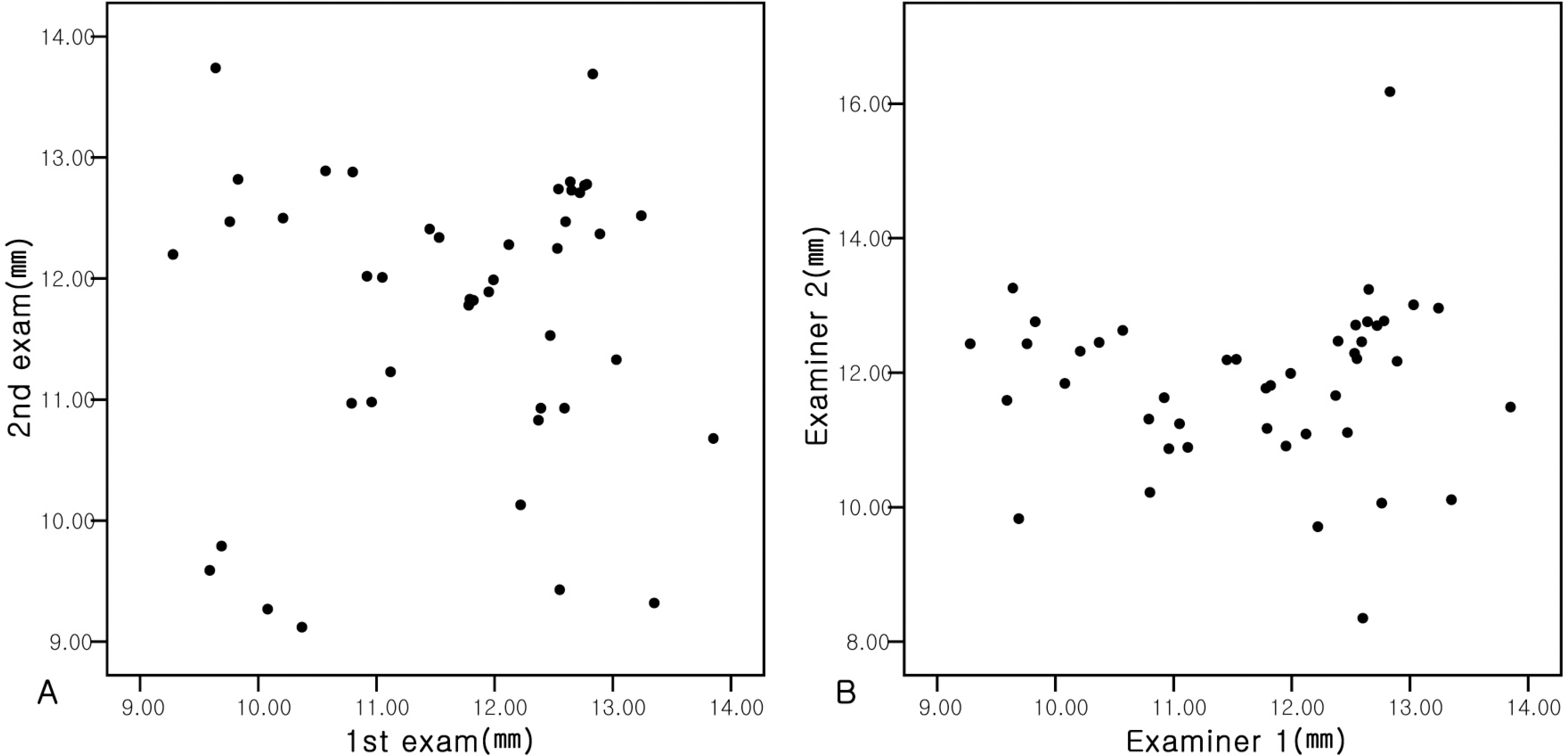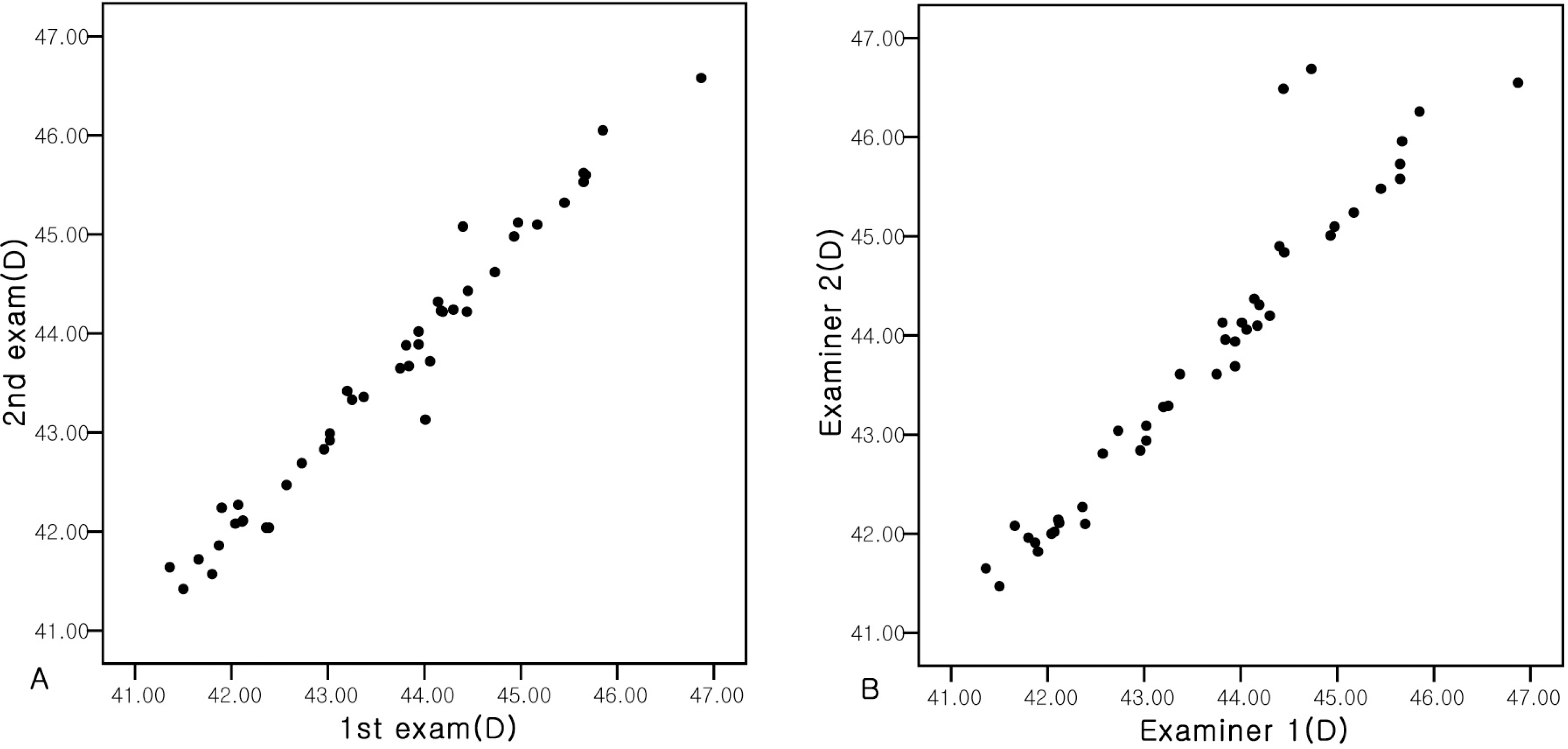Abstract
Purpose
To verify the intra-examiner and inter-examiner repeatability of corneal parameters obtained by GALILEITM.
Methods
Corneal parameters were measured by GALILEI in 44 eyes of 28 healthy subjects. One examiner took the measurements twice and intra-examiner repeatability was evaluated. Another examiner measured the corneal parameters once again and inter-examiner repeatability was evaluated.
Results
Intra-examiner and inter-examiner repeatability were high for corneal parameters including average SimK, flat SimK, steep SimK, average posterior corneal keratometry, flat posterior corneal keratometry, steep posterior corneal keratometry, central corneal thickness, total corneal volume, and average pupil diameter but low for limbus-to-limbus diameter (nasal-temporal and superior-inferior).
Conclusions
Anterior and posterior corneal parameters of GALILEI showed good intra-examiner and inter-examiner repeatability. However, limbus-to-limbus diameter showed poor intra-examiner and inter-examiner repeatability. GALILEI can be useful in clinical applications with special consideration when measuring the limbus-to-limbus diameter.
Go to : 
References
1. Swartz T, Marten L, Wang M. Measuring the cornea: the latest de-velopments in corneal topography. Curr Opin Ophthalmol. 2007; 18:325–33.

2. Jain R, Dilraj G, Grewal SP. Repeatability of corneal parameters with Pentacam after laser in situ keratomileusis. Indian J Ophthalmol. 2007; 55:341–7.
3. de Sanctis U, Missolungi A, Mutani B, et al. Reproducibility and repeatability of central corneal thickness measurements in kerato-conus using the rotating Scheimpflug camera and ultrasound pachy-metry. Am J Ophthalmol. 2007; 144:712–8.
4. Shankar H, Taranath D, Santhirathelagan CT, Pesudovs K. Anterior segment biometry with the Pentacam: Comprehensive assessment of repeatability of automated measurements. J Cataract Refract Surg. 2008; 34:103–13.

5. Chen D, Lam AK. Intrasession and intersession repeatability of the Pentacam system on posterior corneal assessment in the normal human eye. J Cataract Refract Surg. 2007; 33:448–54.

6. Shankar H, Taranath D, Santhirathelagan CT, Pesudovs K. Repeatability of corneal first‐ surface wavefront aberrations measured with Pentacam corneal topography. J Cataract Refract Surg. 2008; 34:727–34.
7. Menassa N, Kaufmann C, Goggin M, et al. Comparison and reproducibility of corneal thickness and curvature readings obtained by the Galilei and the Orbscan II analysis systems. J Cataract Refract Surg. 2008; 34:1742–7.

8. Ciolino JB, Belin MW. Changes in the posterior cornea after laser in situ keratomileusis and photorefractive keratectomy. J Cataract Refract Surg. 2006; 32:1426–31.

9. Seitz B, Torres F, Langenbucher A, et al. Posterior corneal curvature changes after myopic laser in situ keratomileusis. Ophthalmology. 2001; 108:666–72.

10. Kamiya K, Oshika T. Corneal forward shift after excimer laser kera-torefractive surgery. Semin Ophthalmol. 2003; 18:17–22.

Go to : 
 | Figure 2.Scattergram showing intra- (A) and inter-examiner (B) repeatability of limbus to limbus diameter (nasal – temporal). |
Table 1.
Patient demographics
| Number of eyes | 44 |
| Male: female | 8:20 |
| Mean age (years) | 28.1 ± 4.12 (22.0∼38.0) |
| Refractive error (diopter) | −1.84 ± 1.65 (−8.0∼+3.0) |
Table 2.
Intra-examiner repeatability (Guttman split-half points are given for each parameters measured)
| Parameters | Mean± SD | Guttman half split points | |
|---|---|---|---|
| SimK (D) | Sim avg* | 43.63±1.374 | 0.993 |
| Simf† | 42.96±1.311 | 0.982 | |
| Sim s‡ | 44.27±1.500 | 0.991 | |
| Posterior corneal powers (D) | K avg§ | −6.410±0.283 | 0.969 |
| K f∏ | −6.180±0.380 | 0.949 | |
| K s# | −6.640±0.266 | 0.863 | |
| Central corneal thickness (μm) | CCT** | 560.8±28.84 | 0.993 |
| Limbus to limbus diameter (mm) | Nasal-temporal | 11.70±1.198 | 0.137 |
| Superior-inferior | 11.66±1.189 | 0.469 | |
| Total corneal volume (mm3) | 34.16±1.766 | 0.933 | |
| Pupil average diameter (mm) | 2.801±0.566 | 0.918 |
Table 3.
Inter-examiner repeatability (Guttman split-half points are given for each parameters measured)
| Parameters | Mean± SD | Guttman half split points | |
|---|---|---|---|
| SimK (D) | Sim avg* | 43.79±1.508 | 0.975 |
| Sim f† | 43.03±1.355 | 0.990 | |
| Sim s‡ | 44.55±1.780 | 0.935 | |
| Posterior corneal powers (D) | K avg§ | −6.330±0.294 | 0.802 |
| K f∏ | −6.170±0.367 | 0.771 | |
| K s# | −6.630±0.302 | 0.773 | |
| Central corneal thickness (μm) | CCT** | 560.4±29.18 | 0.990 |
| Limbus to limbus diameter (mm) | Nasal-temporal | 11.59±1.156 | 0.077 |
| Superior-inferior | 11.58±1.215 | 0.434 | |
| Total corneal volume (mm3) | 33.37±2.591 | 0.809 | |
| Pupil average diameter (mm) | 2.845±0.602 | 0.962 |




 PDF
PDF ePub
ePub Citation
Citation Print
Print



 XML Download
XML Download